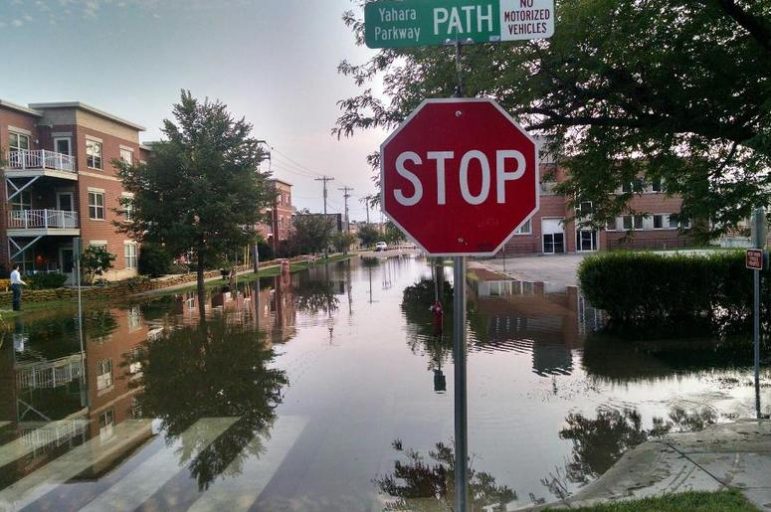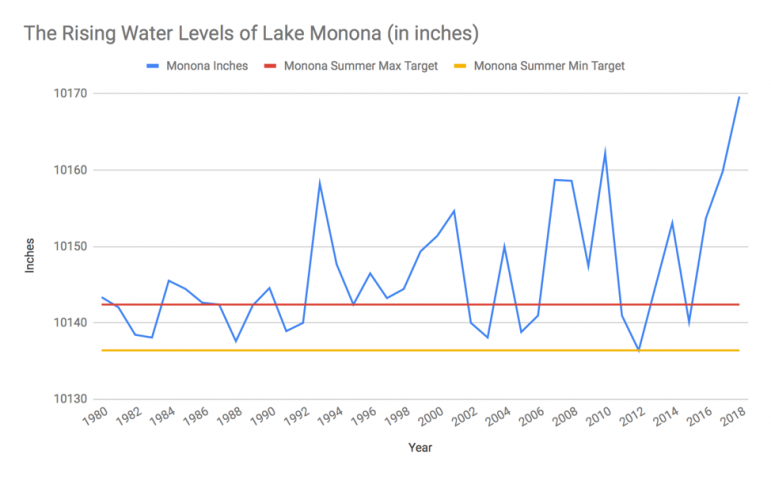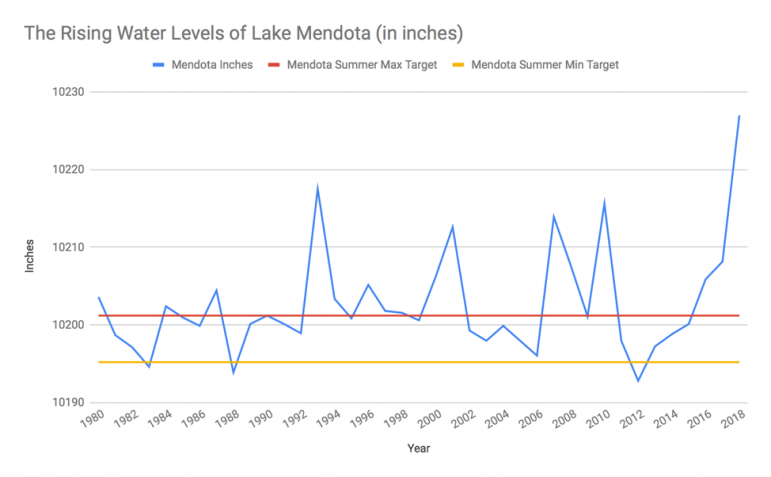With more than three months since the heavy rainfalls hit Madison in August, many of the immediate, visible impacts of flooding in the city have been addressed. However, the potential for future environmental issues still lingers.

The first issue is shoreline erosion which can result from ice damage. As winter approaches, there is some potential for adverse impacts to Madison’s shoreline areas as water freezes at higher-than-normal lake levels.
According to Richard “Dick” Lathrop, a former Wisconsin Department of Natural Resources employee and current honorary fellow with the University of Wisconsin’s Center for Limnology, ice damage to shorelines is one outcome likely to occur when lakes freeze before water recedes to normal winter levels. Lathrop mentioned how the county generally lowers Lake Mendota by about one foot during the summer.
Rising Lake Levels and Erosion
This action helps reduce ice damage to the shorelines, as the expansion of ice affects shoreline structures when shoved onto the shore. Ice damage can eventually result in shoreline erosion and property loss. Although water levels have been brought down, they will still be high as the lakes freeze and cause ice damage to the shoreline.
The precipitation in late August pushed lake levels far above their target summer maximum levels. These targets were set by the Wisconsin Department of Natural Resources back in 1979 in order to avoid inundation and excessive erosion of the shorelines along Dane County’s major lakes.
For Lake Monona, the summer maximum is set at 10,142.4 inches above the average sea level; for Lake Mendota, it’s set at 10,201.2 inches. After the significant rainfall on Aug. 20 and 21, levels rose to 10,170 inches and 10,227.6 inches for Lake Monona and Lake Mendota, respectively.

Addressing the relationship between lake levels and flooding, Kelly O'Ferrell, the Hasler Lab Coordinator at the University of Wisconsin Center for Limnology said, “The lakes can handle some higher water before it becomes a serious problem, but that number is not set in stone, nor would it be the same for each lake. People have lived with the lakes three-fourths of a foot higher than summer max, but two feet higher like last summer is a huge problem.”
In addition to shoreline erosion, the significantly higher lake levels this year could also affect the levels of phosphorus, a nutrient for plant growth. Lathrop also noted that with heavy rainfall comes the potential for more phosphorus to be carried into the lakes.
Impact of Phosphorus on Madison lakes
Increased levels of phosphorus in the lakes can lead to booming algae blooms, or a growth of algae in the lakes. Some types of algae can pose a health hazard to humans and animals, as blooms of blue-green algae in Madison lakes have even caused the temporary closure of city beaches in the past year.
Reducing phosphorus levels in lakes within the Yahara River Watershed is one of the primary areas of focus for the Clean Lakes Alliance, a local nonprofit organization committed to the improvement and protection of lakes, streams and wetlands.
“The big rain event that we had in mid-August that led to flooding sort of just cast a rough year for the lakes,” said Adam Sodersten, the Director of Marketing and Development at the Clean Lakes Alliance.
According to Sodersten, the August rainfall only served to worsen problems associated with the region’s uncommon precipitation patterns that had already occurred earlier in the year.
According to Dick Lathrop, the phosphorus concentrations measured in Lake Mendota around the beginning of November increased some in relation to the past few years, though they were not at an all-time high.

“My take on it is that while a lot of phosphorus entered the lake from all the runoff events including the late August extreme event, a lot of water was being discharged out of the lakes for months in response to all the flooding causing phosphorus to be flushed out of the lakes,” said Lathrop.
Monitoring Algal Blooms
At this time, Lathrop said that there was uncertainty as to whether algal blooms in the Yahara lakes will be more significant in the summer months due to the flooding in 2018, and that this could depend on a variety of factors.
In the past couple of years, the heaviest blue-green algal blooms have occurred in early June when there have been stretches of particularly hot, calm weather. Additionally, zebra mussels, which have become established in Mendota and the lower Yahara lakes, may be another factor that could contribute to more scum-forming blooms in the lake shallows. However, Lathrop said that more research would be needed to better predict zebra mussels’ impact on the quality of the Yahara lakes.





